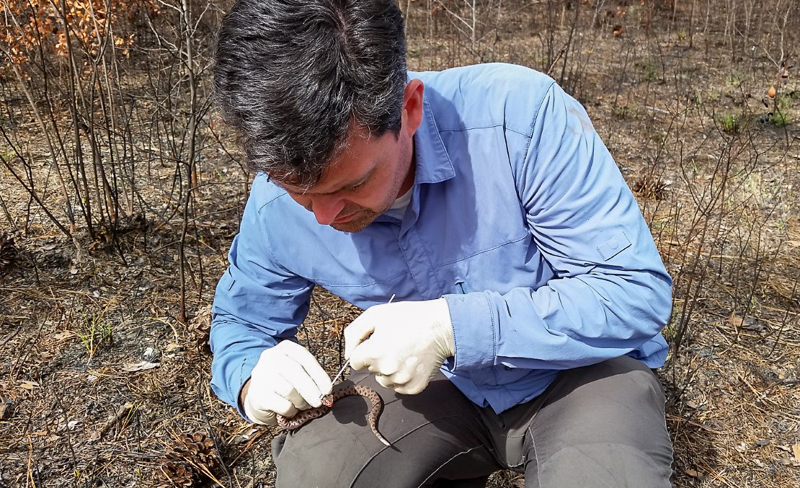Museum staff co-author paper on the prevalence of four pathogens in amphibians and reptiles of North Carolina
For immediate release ‐ July 01, 2021
Contact: Bryan Stuart, 919.707.8861. Images available upon request
 Dr. Bryan Stuart taking a non-lethal skin swab from a Carolina Pigmy Rattlesnake (Sistrurus miliarius) in Onslow County, NC, for use in the study. Photos: Jeffrey G. Hall/NC Wildlife Resources Commission.
Dr. Bryan Stuart taking a non-lethal skin swab from a Carolina Pigmy Rattlesnake (Sistrurus miliarius) in Onslow County, NC, for use in the study. Photos: Jeffrey G. Hall/NC Wildlife Resources Commission.
Just published in Herpetological Review, this paper summarizes an extensive effort to survey for four emerging diseases of reptiles and amphibians (Ranavirus, Batrachochytrium dendrobatidis, B. salamandrivorans and Ophidiomyces ophiodiicola) across North Carolina.
The paper was co-authored by Curator of Herpetology Bryan Stuart, Collections Manager for Herpetology Jeff Beane, Emeritus Curator of Herpetology Alvin Braswell and Dan Dombrowski of Veterinary Services. Other co-authors include colleagues at North Carolina State University, Duke University, UNC Chapel Hill, North Carolina Natural Heritage Program, North Carolina Division of Parks and Recreation, North Carolina Wildlife Resources Commission, Western Carolina University, UNC Greensboro, Lees-McRae College, University of Illinois and The Orianne Society.
Samples were provided to the project by at least two dozen additional people, including Museum volunteers, Museum Junior Curators, students, and others.
This study was funded by a Seed Grant awarded in 2015-2016 from the Triangle Center for Evolutionary Medicine (TriCEM) to Bryan Stuart as PI, with co-PIs Julie Horvath (NRC Genomics & Microbiology Research Lab), Dan Dombrowski (Veterinary Services), Lori Williams (NC Wildlife Resources Commission), Thomas Lentz (NC State) and Brenna Forester (Duke University). The project also received some support from the NCSU Biotechnology Program.
The project involved taking non-lethal skin swabs from 718 amphibians and 254 reptiles, most of which were wild caught across North Carolina, with some captive individuals from the Museum’s Living Collections and the NCSU Veterinary College’s Turtle Rescue Team.
The study revealed, in part, how many wild reptiles and amphibians test positive for three of these pathogens, yet do not appear to be adversely (or at all) affected by them, supporting the hypothesis that these diseases are likely endemic in North Carolina. The fourth pathogen, B. salamandrivorans, was not found anywhere in North Carolina; this very virulent fungus has devastated salamander populations in Europe, but fortunately has not been documented anywhere in the United States yet.
For more information about our upcoming activities, conservation news and ground-breaking research, follow @NaturalSciences on Instagram, Twitter and Facebook. Join the conversation with #visitNCMNS.

